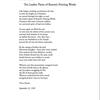2: Alternate translation of Avrom Sutzkever’s poem, “The Leaden Plates of Romm's Printing Works.”
When we read a poem in translation, we are reading someone’s interpretation of the original text.
Suggested Activities: Compare this translation by Seymour Mayne with the translation by Barbara and Benjamin Harshav in resource 1 of this kit. Focus in particular on the first and last stanzas. What similarities do you see in terms of language and content? What are the main differences between the two? What might be some of the advantages and disadvantages of attempting to recreate the poem’s rhyme in English?
Have students read the first and last stanzas of each of the translations out loud, listening to the meter and cadence of the texts. In the Harshavs’ translation, the last two lines of the poem command listeners (perhaps readers like us) to hear the voices of ancient heroes. In Mayne’s translation, it seems like readers are supposed to “recognize” themselves as part of the story. Ask students: which ending do you find more compelling, and why?
Sources: Seymour Mayne, "The Leaden Plates of Romm's Printing Works," In Your Words: Translations from the Yiddish and the Hebrew (St. Catharines, Ontario: Ronald P. Frye & Co., 2017), 42.

